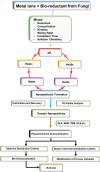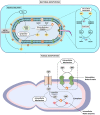Mycology-Nanotechnology Interface: Applications in Medicine and Cosmetology
- PMID: 35677678
- PMCID: PMC9170235
- DOI: 10.2147/IJN.S363282
Mycology-Nanotechnology Interface: Applications in Medicine and Cosmetology
Abstract
In today's time, nanotechnology is being utilized to develop efficient products in the cosmetic and pharmaceutical industries. The application of nanotechnology in transforming bioactive material into nanoscale products substantially improves their biocompatibility and enhances their effectiveness, even when used in lower quantities. There is a significant global market potential for these nanoparticles because of which research teams around the world are interested in the advancements in nanotechnology. These recent advances have shown that fungi can synthesize metallic nanoparticles via extra- and intracellular mechanisms. Moreover, the chemical and physical properties of novel metallic nanoparticles synthesised by fungi are improved by regulating the surface chemistry, size, and surface morphology of the nanoparticles. Compared to chemical synthesis, the green synthesis of nanoparticles offers a safe and sustainable approach for developing nanoparticles. Biosynthesised nanoparticles can potentially enhance the bioactivities of different cellular fractions, such as plant extracts, fungal extracts, and metabolites. The nanoparticles synthesised by fungi offer a wide range of applications. Recently, the biosynthesis of nanoparticles using fungi has become popular, and various ways are being explored to maximize nanoparticles synthesis. This manuscript reviews the characteristics and applications of the nanoparticles synthesised using the different taxa of fungi. The key focus is given to the applications of these nanoparticles in medicine and cosmetology.
Keywords: biological application; biosynthesis; fungi; nanoparticles; nanotechnology.
© 2022 Dhanjal et al.
Conflict of interest statement
The authors report no conflicts of interest in this work.
Figures






References
-
- Mittapally S, Aziz A, Student A, Afnan AA. A review on nanotechnology in cosmetics. Pharma Innov Int J. 2019;8(4):668–671.
-
- Effiong DE, Uwah TO, Jumbo EU, et al. Nanotechnology in cosmetics: basics, current trends and safety concerns—A review. Adv Nanopart. 2019;9(1):1–22. doi:10.4236/ANP.2020.91001 - DOI
-
- Erkoc P, Ulucan-Karnak F. Nanotechnology-based antimicrobial and antiviral surface coating strategies. Prosthes. 2021;3(1):25–52. doi:10.3390/PROSTHESIS3010005 - DOI
Publication types
MeSH terms
LinkOut - more resources
Full Text Sources

